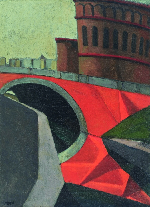LAJOS TIHANYI – A Bohème Artist in Budapest, Berlin and Paris
KOGART House

The last exhibition of Tihanyi's oeuvre was held in 1973 in the Hungarian National Gallery. This new display selects from the holdings of museums, as well as foreign and Hungarian private collections, and promises a rediscovery of one of the finest Hungarian painters.
Lajos Tihanyi reached the top echelon of early 20th-century modern Hungarian painting at a young age—although meningitis had rendered him deaf at the age of eleven, and he had hardly any formal training in the traditional sense.
Composed of vivid colours, the works he made in Hungary – chiefly landscapes, nudes, portraits and still lifes – employ the lessons of Cézanne, Matisse and Picasso. Following the 1919 Soviet Republic, he left the country, and spent some time in Vienna and Berlin, before settling in Paris. The contemporary writers, artists and politicians ha came to know in emigration were the subjects of a series of graphical works, a brilliant portrait gallery. Meanwhile, his painting departed more and more from the principles of verisimilitude, and his pictures fused an emphasis of structure with the representational distortions and the intense palette of expressionism.
Though in 1933, when he joined the Abstraction-Création group in Paris, he was already painting mature abstract works, his untimely death in 1938 prevented this period from completely unfolding. Thanks to his friends, photographers Brassaï and André Kertész, and Jacques de la Frégonniere, the painter, most of his works have survived, and were returned to Hungary in 1970.
Free guided tours from 6 May organized by the KOGART Volunteer Program every Wednesday at 3 pm and every Sunday at 11 am (in Hungarian)
KOGART House
1062 Budapest, Andrássy út 112.
